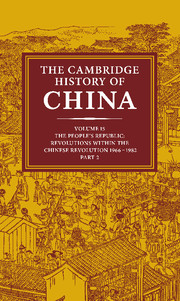Book contents
- Frontmatter
- 1 Mao Tse-tung's thought from 1949 to 1976
- PART I THE CULTURAL REVOLUTION: CHINA IN TURMOIL, 1966–1969
- PART II THE CULTURAL REVOLUTION: THE STRUGGLE FOR THE SUCCESSION, 1969–1982
- 4 The succession to Mao and the end of Maoism
- 5 The opening to America
- PART III THE CULTURAL REVOLUTION AND ITS AFTERMATH
- PART IV LIFE AND LETTERS UNDER COMMUNISM
- PART V THE SEPARATED PROVINCE
- Epilogue: the onus of unity
- Appendixes: meetings and leaders
- Bibliographical essays
- Bibliography
- Index
- Map 1: China’s physical features
- Map 2. PRC: political (Wade–Giles romanization)
- Map 3. PRC: political (pinyin romanization)
- Map 7: Population
- References
4 - The succession to Mao and the end of Maoism
from PART II - THE CULTURAL REVOLUTION: THE STRUGGLE FOR THE SUCCESSION, 1969–1982
Published online by Cambridge University Press: 28 March 2008
- Frontmatter
- 1 Mao Tse-tung's thought from 1949 to 1976
- PART I THE CULTURAL REVOLUTION: CHINA IN TURMOIL, 1966–1969
- PART II THE CULTURAL REVOLUTION: THE STRUGGLE FOR THE SUCCESSION, 1969–1982
- 4 The succession to Mao and the end of Maoism
- 5 The opening to America
- PART III THE CULTURAL REVOLUTION AND ITS AFTERMATH
- PART IV LIFE AND LETTERS UNDER COMMUNISM
- PART V THE SEPARATED PROVINCE
- Epilogue: the onus of unity
- Appendixes: meetings and leaders
- Bibliographical essays
- Bibliography
- Index
- Map 1: China’s physical features
- Map 2. PRC: political (Wade–Giles romanization)
- Map 3. PRC: political (pinyin romanization)
- Map 7: Population
- References
Summary
INTRODUCTION
The Great Proletarian Cultural Revolution was an attempt to shape the future of China. Its method was to change the nature of the Chinese people. It was to be a “great revolution that touches people to their very souls.” The masses were to liberate themselves by class struggle against the main target, “those within the Party who are in authority and are taking the capitalist road.” These so-called Soviet-style revisionists were alleged to be seeking to corrupt the masses by using old ideas to restore capitalism. By transforming the ideological realm - education, literature, the arts - and embracing Mao Tse-tung Thought, the Chinese people were to inoculate themselves against poisonous contagion.
Mao's objective was a China that was pure though poor, more egalitarian and less privileged, more collectivist but less bureaucratic, a society in which all worked as one, not so much because they were led by the Communist Party as because an inner compass - Mao Tse-tung Thought - pointed them toward the magnetic pole of true communism.
The goal of the Cultural Revolution was to provide the right answer to the question, After Mao, what? But success would depend on the answer to an earlier question, After Mao, who? If alleged capitalist-roaders like head of state Liu Shao-ch'i survived the Chairman in positions of power, then China would “change its color.” China must not only be guided by the correct line and policies, but had to “train and bring up millions of successors who will carry on the cause of proletarian revolution.”
- Type
- Chapter
- Information
- The Cambridge History of China , pp. 303 - 401Publisher: Cambridge University PressPrint publication year: 1991
References
- 1
- Cited by

